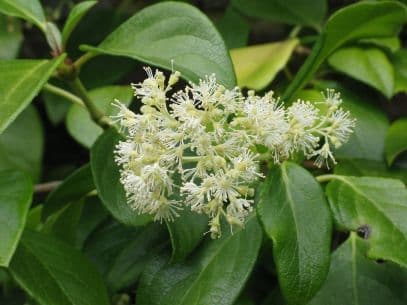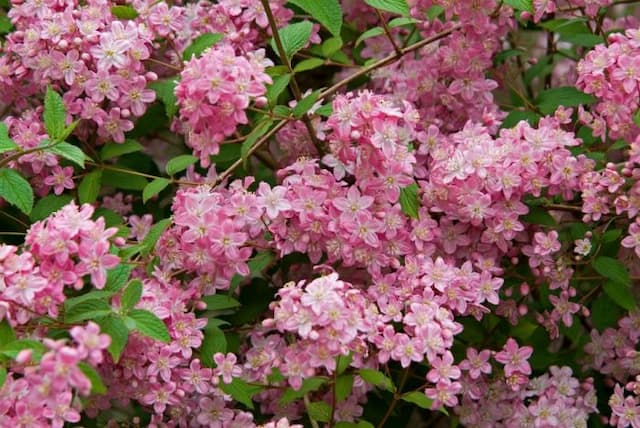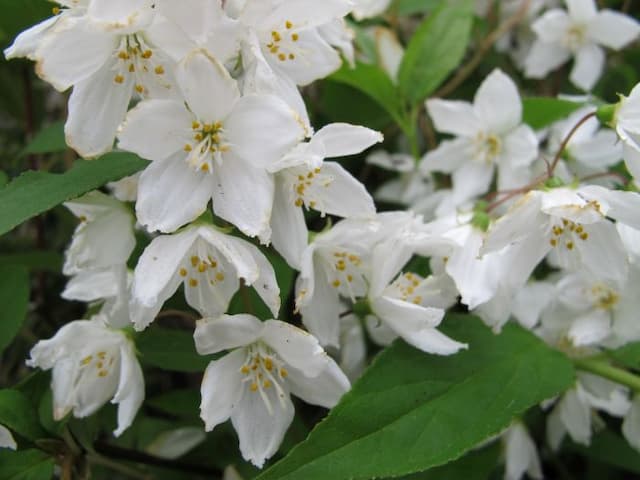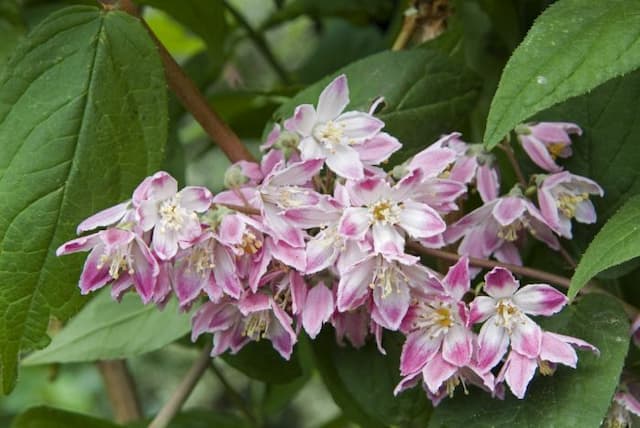Dwarf Panicle Hydrangea Hydrangea paniculata Dart's Little Dot = 'Darlido' (PBR)
![paniculate hydrangea [Dart's Little Dot]](/_next/image?url=https%3A%2F%2Fplants-admin.emdemapps.com%2Fimages%2Fplants%2F%2Fimages%2F604b61374d0c2.png&w=3840&q=75)
ABOUT
The Hydrangea paniculata Dart's Little Dot, known more commonly as the Little Dot Hydrangea, is a deciduous shrub that boasts a distinctive appearance. The Little Dot Hydrangea is known for its abundant flower heads that resemble cones which emerge a soft white and gradually mature to a warm pink as the season progresses. Each individual flower is relatively small and densely packed together with others, contributing to a full, lush look on the flower cones. The foliage of this plant is a deep green color, providing a beautiful contrast to the blossoming flowers. The leaves are ovate with serrated edges, creating a textured effect against the backdrop of the garden. The stems are sturdy, holding up the generous flower heads and maintaining an attractive shape throughout the blooming season. Despite its compact nature, the Little Dot Hydrangea makes a significant visual impact with its charming flowers and robust foliage.
About this plant
 Names
NamesFamily
Hydrangeaceae.
Synonyms
Dart's Little Dot Hydrangea, Darlido Hydrangea.
Common names
Hydrangea paniculata 'Darlido'
 Toxicity
ToxicityTo humans
The Hydrangea paniculata, commonly known as panicle hydrangea, may be toxic to humans if ingested. The plant contains compounds that can release cyanide in the body when chewed or broken down. The symptoms of poisoning from hydrangeas usually include gastrointestinal upset such as nausea, vomiting, and diarrhea. In severe cases, it can lead to more serious symptoms like dizziness, rapid pulse, or increased body temperature. You should always handle plants with care and avoid consuming any part of them, especially if they are not specifically grown for culinary use.
To pets
The panicle hydrangea is toxic to pets if ingested. Like in humans, the plant contains compounds which can release cyanide in the body. If a pet, such as a dog or cat, eats part of a hydrangea plant, they may experience symptoms of toxicity. These can include vomiting, diarrhea, lethargy, and depression. In severe cases, ingestion can lead to more serious health problems such as difficulty breathing and increased heart rate. If you suspect your pet has ingested hydrangea, it is important to contact a veterinarian immediately.
 Characteristics
CharacteristicsLife cycle
Perennials
Foliage type
Deciduous
Color of leaves
Green
Flower color
White
Height
3-4 feet (0.91-1.22 meters)
Spread
2-3 feet (0.61-0.91 meters)
Plant type
Shrub
Hardiness zones
3-8
Native area
Asia
Benefits
 General Benefits
General Benefits- Compact Size: 'Darlido' is a dwarf variety, making it suitable for small gardens and spaces.
- Ornamental Appeal: It offers attractive long-lasting flowers that can enhance the aesthetic of any landscape.
- Easy to Grow: The plant is known for being low maintenance and easy to care for, making it suitable for beginner gardeners.
- Cold Hardy: It is resilient in colder climates, withstanding temperature fluctuations better than some other hydrangeas.
- Long Blooming Period: This hydrangea variety blooms from mid-summer to autumn, providing color for an extended period.
- Variety of Uses: Can be planted in garden beds, borders, as a specimen plant, or in containers for patio display.
- Attracts Pollinators: The flowers can attract bees and butterflies, contributing to the health of your garden ecosystem.
- Seasonal Interest: In addition to the summer blooms, foliage changes color in the fall, adding another layer of interest to the garden.
- Durable: 'Darlido' shows good resistance to many pests and diseases, reducing the need for chemical treatments.
- Adaptable: It can adapt to a range of soil types, though it prefers well-drained, moist soil.
 Medical Properties
Medical PropertiesThis plant is not used for medical purposes.
 Air-purifying Qualities
Air-purifying QualitiesThis plant is not specifically known for air purifying qualities.
 Other Uses
Other Uses- Pressed Flower Art: The delicate blooms of Hydrangea paniculata can be pressed and used in crafting beautiful artworks or bookmarks.
- Photographic Subjects: Due to their compact and attractive clusters of flowers, they are often used by photographers as subjects for botanical photography.
- Fabric Dyes: The flowers can be used to create natural dyes for fabrics, yielding various shades depending on the mordants used.
- Dried Flower Arrangements: These hydrangeas can be dried and included in dried flower arrangements for home decor that lasts beyond their fresh blooming season.
- Wedding Decor: The full blossoms are popular for use in floral wedding arrangements, including centerpieces and bridal bouquets.
- Culinary Garnishes: Although not commonly consumed, the non-toxic blooms can be used as decorative garnishes on special dishes.
- Plant Science Education: This plant can be used in educational settings to teach about plant growth, breeding, and horticulture.
- Crafting Potpourris: The flowers, once dried, can be mixed with other botanicals to create fragrant potpourris.
- Horticultural Therapy: These plants are utilized in horticultural therapy programs to improve mental and physical well-being.
- Frost Tolerance Testing: As a hardy species, Hydrangea paniculata is used in horticulture to study frost tolerance in various climates.
Interesting Facts
 Feng Shui
Feng ShuiThe Hydrangea is not used in Feng Shui practice.
 Zodiac Sign Compitability
Zodiac Sign CompitabilityThe Hydrangea is not used in astrology practice.
 Plant Symbolism
Plant Symbolism- Heartfelt Emotions: Hydrangeas often symbolize heartfelt and genuine emotions, conveying gratitude for being understood or for deep understanding between people.
- Vanity or Narcissism: In some cultures, hydrangeas can represent vanity or narcissism, perhaps because of their showy and abundant flower heads.
- Gratitude: The lavish number of flowers and generous round shape has led some to use hydrangeas as a symbol of gratitude and thanks, often featured in fourth wedding anniversary bouquets to represent appreciation and continued growth in the relationship.
- Apology: Hydrangeas can be given as a symbol of apology, reflecting the sender's regret and desire for reconciliation.
- Frigidity or Dispassion: Historically, hydrangeas have also sometimes been associated with frigidity or dispassion, likely due to their ability to change color depending on the soil pH, which can be interpreted as fickleness or lack of passion.
- Abundance: The lushness of the hydrangea’s blooms can also symbolize abundance and prosperity.
- Endurance: Despite its delicate appearance, the hydrangea is a tough plant that can withstand a range of climates, representing endurance and survival.
 Water
WaterThe Dwarf Panicle Hydrangea should be watered deeply and thoroughly once a week, ensuring that the soil is moist but not waterlogged. During hot or dry spells, increase watering to twice a week, with each session providing about 1 gallon of water per plant. Allow the top inch of soil to dry out between waterings to prevent overwatering. If the plant is in a pot, ensure it has proper drainage and adjust watering if the soil stays wet for prolonged periods.
 Light
LightThe Dwarf Panicle Hydrangea thrives in spots that have morning sun and afternoon shade. While it can tolerate full sun, especially in cooler climates, it prefers a location that protects it from the hot afternoon sun. A partially shaded area that receives sunlight for a few hours a day is ideal for promoting optimal growth and bloom.
 Temperature
TemperatureThe Dwarf Panicle Hydrangea prefers a temperate climate and can tolerate temperatures ranging from the mid 60s to the lower 80s Fahrenheit for ideal growth. It's hardy in USDA zones 3 to 8, which means it can survive minimum winter temperatures down to minus 30 to minus 40 degrees Fahrenheit. During extremely hot weather, the plant may need additional watering to help maintain cool soil temperatures.
 Pruning
PruningThe Dwarf Panicle Hydrangea should be pruned in late winter or early spring before new growth begins. Pruning helps to encourage a strong framework for the blooms and remove any dead or damaged wood. It's typically pruned back by about one-third its total height, which helps to promote vigorous new growth and abundant blooms in the upcoming season. The best time for pruning is after the last hard frost but before the plant leafs out.
 Cleaning
CleaningAs needed
 Soil
SoilFor the Dwarf Panicle Hydrangea, a well-draining, fertile soil with organic matter is ideal. Maintain a soil pH of about 5.5 to 6.5; slightly acidic conditions support richer foliage and bloom colors.
 Repotting
RepottingDwarf Panicle Hydrangeas typically require repotting every 3-5 years, depending on their growth rate and the size of their current container.
 Humidity & Misting
Humidity & MistingDwarf Panicle Hydrangea thrives in moderate humidity levels but is quite adaptable and can tolerate different humidity conditions when established.
 Suitable locations
Suitable locationsIndoor
Ensure bright light, moist soil, and regular pruning for indoor Dwarf Panicle Hydrangeas.
Outdoor
Place in sun to part shade, keep soil moist, and protect from harsh winter wind for outdoor care.
Hardiness zone
3-8 USDA
 Life cycle
Life cycleHydrangea paniculata 'Darlido,' commonly known as Dart's Little Dot, begins its life as a dormant bare-root plant or as a young potted nursery plant. Upon planting, it enters a vegetative growth stage, where it develops a robust root system and foliage through the spring. During summer, Dart's Little Dot transitions to the flowering stage, producing large conical clusters of white flowers that can age to a pink hue. After blooming, it enters a period of senescence in the late fall as temperatures drop, where the leaves may change color before falling off. Over winter, the plant goes dormant, conserving energy and waiting for the warm temperatures of spring to activate the next growing cycle. Each year, Dart's Little Dot will repeat this cycle, gradually increasing in size and bloom quantity.
 Propogation
PropogationPropogation time
Spring to Early Summer
The most popular method of propagation for the Hydrangea paniculata 'Darlido', commonly known as Little Lime® Hydrangea, typically involves softwood cuttings. This process is generally done in late spring or early summer when the plant's new growth is still tender. Gardeners can take cuttings that are about 4 to 6 inches long, making sure each cutting has at least two or three pairs of leaves. The lower leaves are removed, and the cut end of the stem is dipped in rooting hormone to encourage root growth. The prepared cuttings are then placed in a well-draining potting mix and kept moist and warm until roots develop, which usually takes several weeks. It is important to provide a high humidity environment during this period, which can be achieved by covering cuttings with a plastic dome or bag.






![Rose deutzia [Yuki Cherry Blossom]](/_next/image?url=https%3A%2F%2Fplants-admin.emdemapps.com%2Fimages%2Fplants%2F%2Fimages%2F604b6510a383a.png&w=640&q=75)

![Hydrangea [Hot Chocolate]](/_next/image?url=https%3A%2F%2Fplants-admin.emdemapps.com%2Fimages%2Fplants%2F%2Fimages%2F604b5a066e3bd.png&w=640&q=75)
![Hydrangea [Blackberry Pie]](/_next/image?url=https%3A%2F%2Fplants-admin.emdemapps.com%2Fimages%2Fplants%2F%2Fimages%2F604b56e2abc1d.png&w=640&q=75)